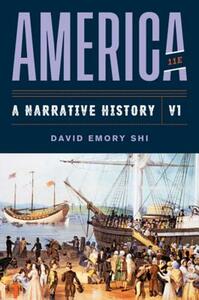Take a photo of a barcode or cover
adventurous
informative
slow-paced
challenging
hopeful
informative
medium-paced
This book tells the story of America mostly by using a "great men" perspective, breaking history down into each president since the Civil War to Obama's First Term. Then it goes through each 4 year bracket of time telling about the domestic and international challenges that faced each president. It was great in that it put disparate things in chronological order so that you could really see when different things that you knew a little about happened relative to each other. But it was a little frustrating because sometimes I think the authors had to scrounge for something to say about each category of things for various presidents. For example, did Lincoln deal with international issues? Sure, but is that really the point? The break between issues divided by president also made some things feel different than themselves. For example, the Vietnam War spanned several presidencies and the book focused on how different presidents dealt with Vietnam, but never dealt with Vietnam as a unified issue. Any unified thought that spans American history was likewise lost in the division into each presidential term. That said, it is really hard to write a history of America that touches on all of the important issues without either losing historical context or losing many of the issues. This book did a pretty good job of spanning that line.
First off, let me clear something up: I AM A HISTORY BUFF. I ADORE HISTORY. I have been known to read history textbooks FOR FUN. So when I say I hated this... it's not just cuz it's a) history or b) a textbook.
It's because it was a HORRIBLY written, unclear, confusing, History Textbook, riddled with historical mistakes and oversights. This is basic history. My time period. It goes up to Lincoln's assassination. I have been studying the 1700's-1900's my entire life. That's my favorite time period. I already know basically everything in this textbook.
Tindall and Shi managed to confuse me, on topics I already knew everything about. In their miserable attempt to create an "interesting" textbook, all they succeeded in doing was make up or exaggerate stuff about certain religious groups or historical figures that is completely false, and confuse people. When they're describing the battles of the Civil War, it's NEARLY IMPOSSIBLE to decipher a) who LED the battles and b) who WON the battles. Kinda important facts, don't ya think?
They were constantly jumping way out of historical chronology, and half the time it was obvious that the authors of this textbook had not personally read any primary sources, or done any real research on the topics they are covering, but rather, they just copied what other people had SAID about those primary resourced. Ever heard of the game telephone? Yeah, this textbook kinda ends up like that. It's hard to sort out the real facts through all the flowering language, and constant time jumps.
Also, the authors seem to hate all Americans. Every single person they talk about, they hate. They're derogatory, and tell you how all these people are horrible, horrible, humans, and show a completely one-sided point of view, without ever giving thought that their might have been MOTIVE for their actions (if the actions actually happened, which you can never really be sure of with this book.)
Please, please, please, I have read countless AMAZING U.S. History textbooks. PLEASE, if at all possible, read a different book. This book will make you hate humans, and history.
It's because it was a HORRIBLY written, unclear, confusing, History Textbook, riddled with historical mistakes and oversights. This is basic history. My time period. It goes up to Lincoln's assassination. I have been studying the 1700's-1900's my entire life. That's my favorite time period. I already know basically everything in this textbook.
Tindall and Shi managed to confuse me, on topics I already knew everything about. In their miserable attempt to create an "interesting" textbook, all they succeeded in doing was make up or exaggerate stuff about certain religious groups or historical figures that is completely false, and confuse people. When they're describing the battles of the Civil War, it's NEARLY IMPOSSIBLE to decipher a) who LED the battles and b) who WON the battles. Kinda important facts, don't ya think?
They were constantly jumping way out of historical chronology, and half the time it was obvious that the authors of this textbook had not personally read any primary sources, or done any real research on the topics they are covering, but rather, they just copied what other people had SAID about those primary resourced. Ever heard of the game telephone? Yeah, this textbook kinda ends up like that. It's hard to sort out the real facts through all the flowering language, and constant time jumps.
Also, the authors seem to hate all Americans. Every single person they talk about, they hate. They're derogatory, and tell you how all these people are horrible, horrible, humans, and show a completely one-sided point of view, without ever giving thought that their might have been MOTIVE for their actions (if the actions actually happened, which you can never really be sure of with this book.)
Please, please, please, I have read countless AMAZING U.S. History textbooks. PLEASE, if at all possible, read a different book. This book will make you hate humans, and history.
So I used this textbook (or a previous edition of it) for AP US History in high school, and I keep it around as a reference point for things I learned (incorrectly) in high school--basically to get a sense, as a scholar and future professor (hopefully,) of what students are learning and what the dominant narratives being spread are. I was told in high school that the textbook was chosen because it was the cheapest option with color photographs, though that was in 2010, so lord only knows what the market looks like now. I will say that even at the time, the text was riddled with typos, with some pages making almost no sense at all because sentences repeated themselves or words were missing. There were also images that were misidentified--a picture of the Constitution was labeled as the Declaration of Independence (or vice versa). Adam Jortner has also written about this textbook in his essay in Why You Can't Teach US History Without American Indians and the way maps are used to eliminate indigenous presence (an essay I strongly recommend in a book I strongly recommend!) so that is also something to consider. It did prepare me to be able to spit back the dominant narrative on a standardized test, so I guess it did its job, but I'm sure there are at last marginally better books out there.




